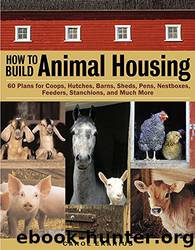How to Build Animal Housing: 60 Plans for Coops, Hutches, Barns, Sheds, Pens, Nestboxes, Feeders, Stanchions, and Much More by Carol Ekarius

Author:Carol Ekarius [Ekarius, Carol]
Language: eng
Format: epub
ISBN: 9781580175272
Amazon: 1580175279
Publisher: Storey Publishing, LLC
Published: 2004-05-02T04:00:00+00:00
FRAMING CONNECTORS
These framing connectors are the most common. Although you may not be required by code to use connectors, they are convenient and easy to use, making them a wise investment.
Stretchers are the most common concrete blocks and come in full and half sizes; corner blocks are flat on one edge. Interior partitions can be built with full-width blocks, but code also allows the use of narrow blocks.
CONCRETE AND CEMENT
Concrete is usually used for foundations and floors but can also be used for walls. It’s made basic components: cement, water, and washed aggregate (sand and/or stone). It has tremendous compressive strength, meaning it can support lots of weight, but low tensile strength, meaning it tends to bend and twist. To reduce bending and twisting, it is reinforced with wire mesh or reinforcing bar (rebar).
Portland cement is made from powdered and burned limestone or clay, and gypsum; these ingredients are mixed with water to create a paste that hardens as it dries and can glue aggregate (pieces of rock) together. The type and proportion of aggregate varies depending on locale and specified use. The quality of concrete is dependent on the ratio of cement to water to aggregate (a thicker paste produces stronger concrete than a watery paste). Mortar is cement with additional lime and screened sand, and it is used for laying up a concrete block (or brick) wall.
For very small jobs, you can purchase premixed bags of dry concrete. They come in half-cubic-foot sizes, so two bags would fill a slab approximately 4 inches thick by 20 inches square. For any sizable job, it’s best to order concrete from a ready-mix operator. Most operators can help you determine the best mixture and the amount you will need for the job. They take orders in cubic yards, and 1 cubic yard is equal to 27 cubic feet.
Caution with Wet Concrete
Download
How to Build Animal Housing: 60 Plans for Coops, Hutches, Barns, Sheds, Pens, Nestboxes, Feeders, Stanchions, and Much More by Carol Ekarius.epub
This site does not store any files on its server. We only index and link to content provided by other sites. Please contact the content providers to delete copyright contents if any and email us, we'll remove relevant links or contents immediately.
The Body: A Guide for Occupants by Bill Bryson(4947)
Audition by Ryu Murakami(4820)
Adulting by Kelly Williams Brown(4462)
Housekeeping by Marilynne Robinson(4301)
Be in a Treehouse by Pete Nelson(3922)
Zero Waste Home by Bea Johnson(3761)
Seriously... I'm Kidding by Ellen DeGeneres(3561)
Better Homes and Gardens New Cookbook by Better Homes & Gardens(3508)
The Healing Self by Deepak Chopra(3450)
Barkskins by Annie Proulx(3285)
Hedgerow by John Wright(3258)
The Cellar by Natasha Preston(3241)
Spark Joy by Marie Kondo(3230)
The Genius of Japanese Carpentry by Azby Brown(3208)
The Life-Changing Magic Of Tidying Up- The Japanese Art Of Decluttering And Organizing (v5.0) by Marie Kondo(3195)
120 Days of Sodom by Marquis de Sade(3159)
Work Clean by Dan Charnas(3034)
The Book of Numbers by Peter Bentley(2896)
A Monk's Guide to a Clean House and Mind by Shoukei Matsumoto(2854)
